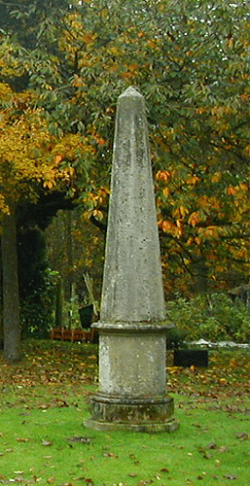The victory plantations and their monuments
|
The Rt Hon Frederick Montagu laid out plantations near his home at Papplewick Hall to commemorate the great naval victories of his time e.g. the battles of St Vincent (Feb 1797), the Nile (Aug 1798) and Trafalgar (Oct 1805) and the naval commanders who served. He did so to replenish the stocks of timber which were in short supply at that point in the Napoleonic Wars. Each plantation originally contained a commemorative obelisk, but in 2021 only two survive (The ‘Howe’ memorial and the ‘Vincent’ memorial. Both are listed structures, and both are on private property.) The plantations were felled for timber in the 20th century, but three of the sites are still marked by woodland. The obelisks and their history were described in the ‘Guardian’ newspaper (published in Nottingham) dated 5th December 1941, and later information was published in the same newspaper on 22nd October 1948. |
|||
| The Obelisks |
|||
 Nelson’s monument commemorates the admiral who commanded naval forces at Trafalgar and the Nile. It stood in the wood to the south of the corner of Forest Lane and the Mansfield Road. In 1948 the Guardian (local paper) described the monument as “a tapering shaft, rising from an octagonal plinth to a height of 13ft. A raised shield on the plinth is inscribed ‘Nelson Plantation. August 1st 1798. FM‘” Nelson’s monument commemorates the admiral who commanded naval forces at Trafalgar and the Nile. It stood in the wood to the south of the corner of Forest Lane and the Mansfield Road. In 1948 the Guardian (local paper) described the monument as “a tapering shaft, rising from an octagonal plinth to a height of 13ft. A raised shield on the plinth is inscribed ‘Nelson Plantation. August 1st 1798. FM‘”
Warren’s monument commemorates Sir John Borlase Warren who commanded British forces blockading Brest, and who disrupted a French invasion of Ireland in August 1798. It stood in the Warren plantation, to the south of Forest lane. The monument was reported as ruined by 1948, but the inscription read “Warren Plantation. August 12th 1798. FM“. Duncan’s monument stood in a plantation to the east of Blidworth Waye at the top of Walter’s Hill. It commemorated Viscount Adam Duncan who commanded the naval forces who defeated the Dutch at the Battle of Camperdown in October 1797. The plantation of mature beech trees was felled and the masonry of the monument removed in the winter of 1920-21. Howe’s monument was erected in the plantation to the east of Mansfield Road. It was moved and conserved in 2003, when the sand quarry was enlarged. It stands on private land. It commemorates the victory of forces commanded by Lord Howe at the Battle of Ushant in June 1794. Vincent monument commemorates the victory of Sir John Jarvis (Earl St Vincent) and Lord Horatio Nelson at Cape St Vincent in February 1797. It was erected in Vincent plantation to the north of Forest Lane. It is still in situ, standing in the grounds of a private property, shown in the picture to the left. George III monument stood in a plantation between Mansfield Road and Longdale Lane, on a hilltop overlooking Forest farm. In 1948 the local paper, the Guardian, reported “Three years ago the tall column rising from a square base succumbed to a hard winter, collapsed and fell in two pieces. Today it lies among the long grass and the rest of the stonework is crumbling, although the inscription is still decipherable. It reads “GEORGIO TERTIO REGI PIO MAGNANIMO PATRIE PATRIAE DDD XV MAII MDCCC” [to George III, a virtuous and high-minded king, the father of his country, given and dedicated by F.M. 15th May 1800]
|


